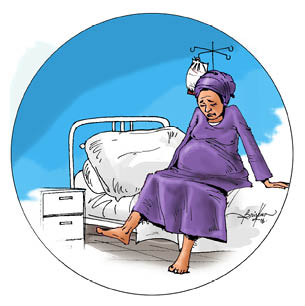Mrs Oluwatoyin managed to sip the liquid substance in her cup and dropped it in the locker beside her hospital bed. Being a lover of solid foods commonly referred to a “swallow” in the local parlance, the decision by nurses at the Ilorin General Hospital to stop her from eating such food after a successful three-hour operation hit her like a thunderbolt.
“They said I can only take liquid food for now because of my condition, and I am not very uncomfortable with that,” she told Daily Trust.
At Arise TV/CDD town hall: Atiku, Obi, Kwankwaso, Abiola list strategies to combat insecurity
We’ll recover ecological funds disbursed to wrong MDAs – Reps
For Hannah Omolara, whose three children were delivered through caesarean section, she was told to avoid eating bread and stop any physical activity like pounding yam or even turning amala, for a period of six months.
On her part, Hajiya Rahinat had to be treated for several days to control her blood pressure before her scheduled date due to the narrative she had been exposed to about caesarean section.
Meanwhile, Dr Ramat Mohammed-Nasir, has described caesarean session as a surgical procedure whereby an incision (a cut) is made on the abdominal wall and anterior uterine wall in order to deliver a baby and other products of conception such as placenta and membrane. Simply put, it means the birth of a baby through abdominal delivery.
She listed conditions that could warrant its recommendation by doctors to include the size of the baby (like 6.5kg) for a woman who is pregnant for the first time; obstructed labour despite the contraction going well and the opening of the cervix but the baby failing to come; having breech presentation where the baby comes with the leg; among others.
She added that the four types of caesarean sections, depending on the condition of the mother and child, are elective, scheduled, emergency and urgent.
Mohammed-Nasir, who is a resident doctor, Department of Obstetrics and Gynaecology, University of Ilorin Teaching Hospital (UITH), said caesarean session is different from vaginal delivery in the sense that their root of delivery differs.
“The latter is a process whereby the fetus and products of conception such as the placenta and the cord are delivered via the vagina, while the former is an abdominal delivery whereby the baby and products of conception will be delivered via the abdomen.
Myths
The gynaecologist said, “Many times, most women usually decline a caesarean section for the first time after counselling because they are seen as weak and afraid to undergo the stress of labour and that only strong women deliver through the vagina.”
Often, whenever a woman has a caesarean section, she will be prevented from eating some foods, such as bread and others. They claimed that it usually prevents them from having constipation. No. Any woman who has a caesarean section is the same as anybody who has a vaginal delivery and can eat anything she likes after discharge.
Both vaginal and abdominal deliveries have their individual challenges, and neither one is better nor superior to the other. However, the complications that can occur in caesarean section, being a surgical process, are much more than in a vaginal delivery.
There is also the erroneous belief that a woman who has a caesarean section will always deliver via it, which is why some usually decline, but the answer is no.
She said, “There are indications for any caesarean section to be done and for anybody to have a caesarean section again in her second or third delivery means what caused the first reason is still present and may likely cause a threat to both the mother and the child.
When is caesarean section required?
For a woman to require a caesarean section, Dr Ramat said, “No medical doctor will decide to do a caesarean section for any woman without the need for it. For example, if a woman has cord prolapse, which is when the cord is coming out of the vagina before or during labour, the baby may likely die as a result of compression of the cord if nothing is done.
“There can also be cord presentation when, during a vaginal examination in labour, the doctor notices the cord is intact with the membrane yet to rupture or preeclampsia (tendency to have elevated blood pressure during pregnancy).
Additionally, when the cervix fails to open and there is a need for a faster mode of delivery.
Indications can also include having had a previous caesarean section or a myomectomy and the endometrium, that’s the inside of the uterus, had opened or breeched, the weight of the baby, bleeding per vaginum (placenta previa or abruptio placenta where the baby is alive); the woman having difficulty in delivery despite long hours of labour (obstructed labour) or the uterus is contracting, the cervix is opening, but the baby didn’t come.
It can also happen in a woman that the fetus’s filter heart rate is not okay (very high or below the normal level) despite all the interventions from the doctor.
It also happens when a woman has an ultrasound (biophysical profile) and the result is abnormal, such that the foetus or baby has been compromised intrauterine, which may lead to stressful labour or vaginal delivery that can kill the baby.
Why most women are afraid
The medical expert listed the fear of the expenses “because caesarean sections cost 10 times or more in some centres to vaginal deliveries.
She also linked it to the myths around it, like people calling those who undergo caesarean section weak women.
She said, “The level of enlightenment is not enough, leading to the spread of wrong information around it. Some still believe that any woman who wants to undergo a caesarean section will likely die.
“However, complications may occur for which there are solutions. If a woman is bleeding during a caesarean section, the appropriate thing is to stop it and transfuse if it’s much, to be able to replace the blood that has been lost.”
She advised women, mothers-in-law and husbands who oppose caesarean section to remember that the lives of the mother and baby are very important and they can both be saved with the process.
“This should be the most important thing. No husband or mother-in-law has the right to oppose a caesarean section; it is only the patient who can avoid or sign the consent (form).
“But because of the environment we find ourselves in, a third-party is not necessary, especially if the woman is conscious and has the mental status to do and know the right thing.
“If a mother-in-law or husband decides to oppose it, the wife can go ahead as long as there is a need for it and she has the money.”
She, therefore, stressed the need for women to empower themselves. “It is her life that is at stake, not that of the husband or the mother-in-law.”
“Women who have undergone it should always follow all the counsel given by the doctor after discharge and wait for at least two years before having another pregnancy.
“The issue is that affected women should see themselves as heroes who took a lot of striving and never relented in delivering to the world a precious baby via a surgery that might take one or two hours.
“They are the real heroes, the real mother, who has strived, made sacrifices to bring forth a baby to life via a procedure for which they never knew the outcome,” she added.

 Join Daily Trust WhatsApp Community For Quick Access To News and Happenings Around You.
Join Daily Trust WhatsApp Community For Quick Access To News and Happenings Around You.

